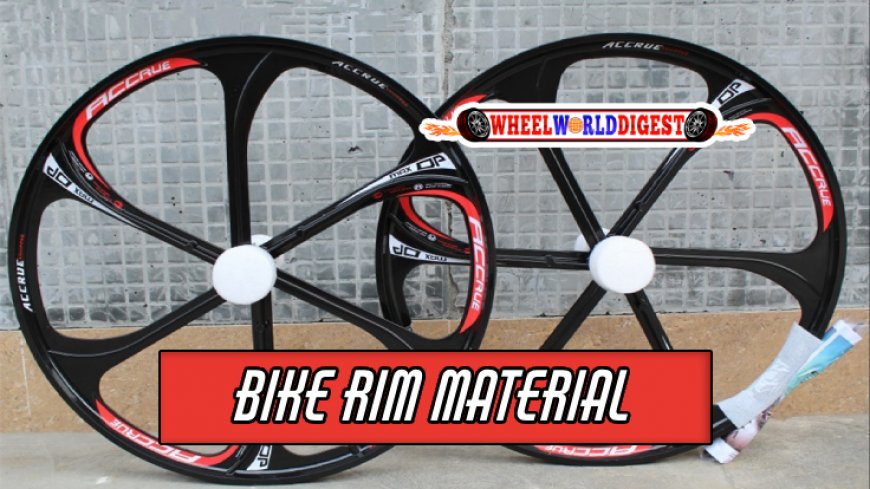The Influence of Material on Bike Rim Efficiency
Grasp the significant role materials play in bike rims. Understand how they affect your rides and your bike's overall mechanics.

The world of cycling gets more intriguing when you dive into the details. One such detail is the bike rim material, often overlooked but more significant than one might think. How do different materials shape the efficiency of your bicycle? Let's delve into this question.
The Significance of Bike Rim Material
Your bike's efficiency is more than just its design or brand. The choice of material in your bike rims plays a critical role in creating that smooth or rugged ride, making bike rim material a subject worth discussing.
Table of Contents
- Materials Used in Bike Rims
- Aluminum Bike Rims
- Carbon Fiber Bike Rims
- Steel Bike Rims
- Bike Rim Material Comparison
- How Does Bike Rim Material Influence Your Ride?
- Choosing the Right Bike Rim Material
Materials Used in Bike Rims

Within the cycling world, the three broadly used materials for bike rims are aluminum, carbon fiber, and steel. But what components make each of these materials special? Let's navigate through them.
Aluminum
Often employed for its lightweight and cost-effectiveness, aluminum is a prime choice for many bicycle manufacturers. Aluminum rims are known for their superior braking surfaces, making them ideal for wet conditions.
Carbon Fiber
A material that screams 'high-end,' carbon fiber, is a top-tier choice for many professional bikers. Noted for their exceptional stiffness and lightness, carbon fiber rims offer a significant advantage in competitive biking. However, their price tag might be disheartening to some.
Steel
Steel rims are a nod to the old biking days. More robust than aluminum and carbon fiber, steel rims are often heavier but are second to none when it comes to durability. They're an excellent choice for those looking for longevity.
Aluminum Bike Rims
Okay, now let's talk in detail about aluminum rims.
Aluminum rims bring a lot to the table:
- Lightweight: The lightweight nature of aluminum makes your ride smoother and accelerates with less effort. It's perfect for bikers who value responsiveness and agility.
- Cost-effective: Compared to their carbon fiber counterparts, aluminum rims are more economically sound. They provide excellent performance without breaking the bank.
- Excellent braking surface: Aluminum provides a superior braking surface, making it far safer, particularly in wet conditions.
But, it's not all roses. Aluminum rims are more prone to wear and tear. Regular maintenance is a must especially if you're a regular biker.
Carbon Fiber Bike Rims
Carbon fiber bike rims are a choice for fashtionistas and top-performance seekers in cycling. The high-tech appeal of carbon fiber combined with its benefits makes it a bicycle superstar.
Some key features of carbon fiber rims are:
- Stiffness: Carbon fiber is well recognized for its impressive stiffness. This property results in better transfer of power, making carbon fiber rims an excellent choice for competitive biking.
- Lightweight: Yes, you read it right—carbon fiber is even lighter than aluminum. This ultralight material makes your rides faster and more agile.
- Customizable: Unlike metals, carbon fiber can be easily molded during the manufacturing process, delivering a myriad of shapes and designs to complement your bike aesthetics.
However, like everything else, carbon fiber rims have their drawbacks. They are notorious for their high cost and reduced braking performance in wet conditions. Plus, they are fragile, and harsh impacts can cause cracks or breaks.
Steel Bike Rims
Invoking nostalgia, steel bike rims transport us back to the dawn of cycling. They are the embodiment of the saying, "Old is Gold." If you're new to the biking world, you might wonder what's so special about them. So here's the rundown:
Durability
First and foremost, steel rims are incredibly robust. Steel is much more resistant to dents and scratches compared to aluminum and carbon fiber rims. A "long-lasting" staple, these rims can endure harsh terrains and daily use, standing the test of time with grace.
Price
You might assume that the durability makes steel rims the most costly option. Surprisingly, that's not the case. Steel bike rims are usually quite affordable. Their budget-friendly nature coupled with their durability provides exceptional value for money.
However, everything has a trade-off. Given their sturdiness, steel rims are heavier than both aluminum and carbon fiber. The added weight might slow you down and make the biking experience less agile. So, while they're robust and reliable, they might not be the best choice for someone seeking speed.
Bike Rim Material Comparison
In the grand scheme, there isn't a 'good' or 'bad' material. It all depends on your individual needs, preferences, and how you intend to use your bike. To simplify, let's put all these materials side by side:
| Aluminum | Carbon Fiber | Steel | |
|---|---|---|---|
| Weight | Lightweight | Ultralight | Heavy |
| Durability | Moderate | Fragile | Robust |
| Cost | Affordable | Expensive | Reasonable |
How Does Bike Rim Material Influence Your Ride?

Your bike rim's material directly impacts your ride in many ways, from the speed and handling to the longevity of your wheels. Lighter rims like those of carbon fiber and aluminum allow for quicker acceleration and easier climbs.
In contrast, heavier steel rims might slow you down a bit, but their sturdiness accounts for a more grounded feel and long-lasting Bible rim life.
However, it's not just about the ride. The material also influences the maintenance needs. Aluminum and carbon fiber rims need regular check-ups to ensure any cracks or wear are addressed, whereas steel rims require less frequent maintenance.
Choosing the Right Bike Rim Material
So, which bike rim material should you choose? Well, it depends.
For an everyday commuter bike or a leisure ride, aluminum offers a good balance between weight and affordability. If you are into high-end racing or looking for cutting-edge performance, the lightweight and stiffness of carbon fiber might be worth the added cost. And, if durability is your top concern, you can go old-school with steel rims.
Remember, every material has its pros and cons. Keep your needs in the forefront, consider your budget, and take the plunge. After all, biking is all about the ride, the thrill, and the joy of the journey.
What's Your Reaction?









































































